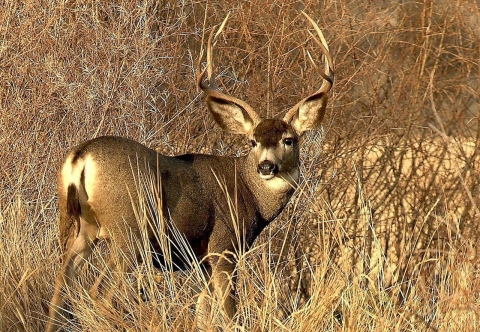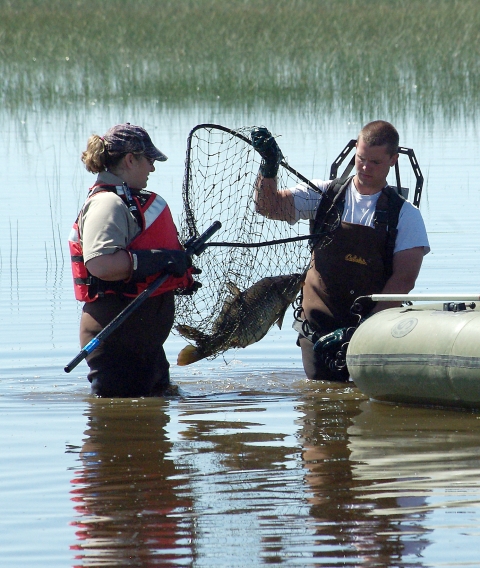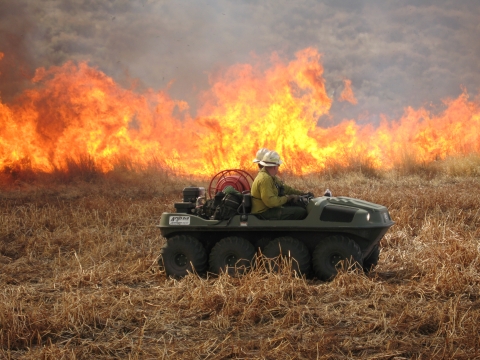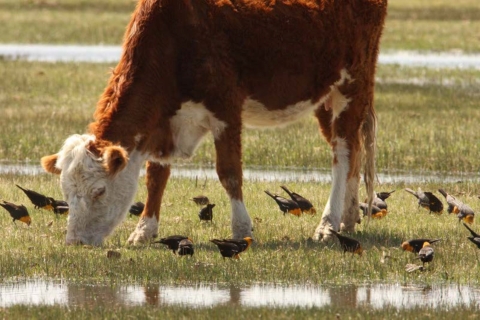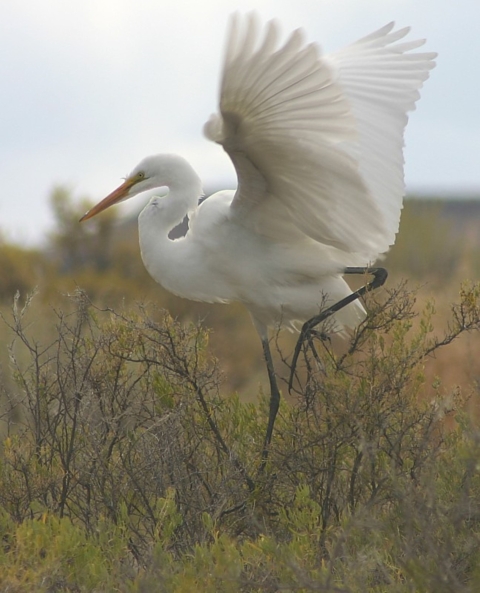What We Do
The National Wildlife Refuge System is a series of lands and waters owned and managed by the U.S. Fish and Wildlife Service. Wildlife conservation is at the heart of the Refuge System. It drives everything we do from the purpose a refuge is established, to the recreational activities offered there, to the resource management tools we use. Selecting the right tools helps us ensure the survival of local plants and animals, and helps fulfill the purpose of Malheur National Wildlife Refuge. Scroll down to learn more about What We Do - MANAGEMENT AND CONSERVATION, COMPREHENSIVE PLAN (CCP), LAW ENFORCEMENT, and LAWS AND REGULATIONS.
Management and Conservation
Refuges use a wide range of land management tools based on the best science available. Some refuges use prescribed fires to mimic natural fires that would have cleared old vegetation from the land helping native plants regenerate and local wildlife to thrive. Other refuges contain Wilderness areas where land is largely managed passively. The management tools used are aimed at ensuring a balanced conservation approach where both wildlife and people will benefit.
Malheur National Wildlife Refuge Conservation Toolbox
- Water management to enhance aquatic health and wildlife habitat needs
- Prescribe burns to achieve wildlife habitat health and reduce hazardous fuel
- Haying and rake-bunch grazing to maintain and enhance wildlife habitat types
- Integrated Pest Management to eradicate, control, or contain pests and invasive species invasive species
An invasive species is any plant or animal that has spread or been introduced into a new area where they are, or could, cause harm to the environment, economy, or human, animal, or plant health. Their unwelcome presence can destroy ecosystems and cost millions of dollars.
Learn more about invasive species
Water Management - Lake and Wetland Habitats
The emphasis of the management direction is to improve the aquatic health of the Refuge’s lake and wetland habitats, and to enhance the feeding, resting, and nesting components necessary for a variety of shore/wading birds, waterfowl, and other wildlife species. This will be achieved largely through carp population control, an invasive fish species. As turbidity decreases and submergent vegetation and associated invertebrate species become more abundant, the productivity of Malheur Lake and of other water bodies within the Refuge (e.g., Boca Lake and Warbler Pond) will increase. Because of the sheer size and complexity of the aquatic health problem, primarily due to carp, a variety of assessment and control tools will be needed to effectively address it. Existing partnerships such as the Aquatic Health Coalition (made up of Federal, State, nongovernmental organizations, and Tribal participants) will assist in strategizing and implementing the most effective suite of control, inventory, funding, and monitoring methods. Although the overall carp assessment and control strategy for the Harney Basin is currently being considered, it would incorporate methods successfully implemented worldwide and customized, as needed, to suit the Refuge. Strategic assessments of lake, river, and wetland habitats and carp population dynamics would guide control activities and provide an enhanced understanding of the system’s innate ability to recover from carp impacts. Control strategies would include, but not be limited to, the application of piscicide, chemo-attractants, chemo-repellants, barriers, commercial harvest, angling, and water manipulation. The need for continued amendments to and the construction of additional strategically placed in-stream structures (i.e., traps, screens, and fish wheels) that allow native fish passage fish passage
Fish passage is the ability of fish or other aquatic species to move freely throughout their life to find food, reproduce, and complete their natural migration cycles. Millions of barriers to fish passage across the country are fragmenting habitat and leading to species declines. The U.S. Fish and Wildlife Service's National Fish Passage Program is working to reconnect watersheds to benefit both wildlife and people.
Learn more about fish passage and impede/prohibit carp movement through the system would also be considered.
Water Management - Wetlands and Terrestrial Habitats
Wetlands and terrestrial habitats will continue to be managed to promote the life-history needs of focal resources. The overarching theme for the management of wetland and terrestrial habitats will be greater flexibility in identified strategies to adequately meet establishing objectives. Flexibility is critical for maintaining a variety of plant communities within habitats, such as emergent marsh, wet meadow, and dry meadow, to meet foraging, breeding, brood rearing, and other life-cycle needs of migratory birds and other native wildlife. For example, bobolinks and sandhill cranes both depend on wet meadows during the breeding season. They do, however, differ greatly in their use of and the conditions needed within these meadows. To address the wide assortment of needs found within each habitat type, vegetation management tools will address the accumulation of litter and plant community succession. Tools will include, but will not be limited to, traditional late summer haying and autumn/winter rake-bunch grazing (to meet the foraging needs of wildlife species that arrive early) and highly prescriptive warm-season (growing season) grazing, mowing, farming, extended dewatering, etc. (to reclaim acres lost to invasive plants, such as common cattail and reed canarygrass) or to rehabilitate communities that have transitioned beyond desired conditions.
Prescribed Fire
The current Refuge Fire Management Plan (FMP) based on the 1985 Refuge master plan and step-down plans was updated in 2010. Under this FMP the Refuge is designated as a single Fire Management Unit (FMU). The FMP will be revised and approved at the Regional level and will act as a step-down plan to Malheur's CCP. An approved FMP allows a manager to consider a wide range of management responses to wildfires and to conduct prescribed fires. The FMP contains strategic and operational elements that describe how to manage applicable fire program components such as response to unplanned ignitions, hazardous fuels, and vegetation management, burned area emergency stabilization and rehabilitation, prevention, community interactions, collaborative partnerships roles, and monitoring and evaluation programs. Prescribed fire will be used in areas where it is the most appropriate tool to achieve habitat and hazardous fuels reduction goals. Prescribed burns will generally be conducted in the late winter to meet litter management objectives, but may be done at other times depending on desired outcomes.
Haying and Rake-bunch Grazing
Livestock grazing and haying have been used in the past at Malheur and will be used in the future as tools to provide optimum conditions for wildlife (specifically, foraging areas for waterfowl, waterbirds, and shorebirds; pairing habitat for waterfowl; nesting habitat for shorebirds; and nesting habitat for certain passerines) and, where possible, to improve biological integrity (native plant diversity; hereafter, restoration) in Refuge plant communities. The primary habitat types where grazing and haying will be used are wet meadows (meadow habitats with standing surface water during the growing season) and reed canarygrass areas (an undesirable exotic wet meadow grass that has spread to dominate some Refuge fields). Livestock grazing may also be used when necessary to maintain or restore other habitats. Approximately 12,000 to 15,000 acres across the Refuge’s 20,000 to 25,000 acres of wet meadow habitat type will be treated in the initial calendar years. Actual treatment levels will vary on a field-to-field basis depending on the area-specific objectives of focal species. For example, higher levels of treatment will typically occur to provide conditions most favorable for sandhill crane foraging and bobolink nesting (e.g., southern Blitzen Valley) and idle conditions will dominate where the use of grass meadows for waterfowl nesting is emphasized (e.g., north of Warbler Pond in the Double-O Unit). Application of these treatments may be adjusted as more information is gleaned through inventory and monitoring activities and analyzed by Refuge staff, the Ecology Work Group, and other collaborators.
Integrated Pest Management
An integrated pest management (IPM) approach will be used, where practicable, to eradicate, control, or contain pest and invasive species (herein collectively referred to as pests) on refuge lands. IPM will involve using methods based upon effectiveness, cost, and minimal ecological disruption, which considers minimum potential effects to non-target species and the Refuge environment. Pesticides may be used where physical, cultural, and biological methods or combinations thereof, are impractical or incapable of providing adequate control, eradication, or containment. If a pesticide is needed on the Refuge, the most specific (selective) chemical available for the target species will be used. Environmental harm by pest species refers to a biologically substantial decrease in environmental quality as indicated by a variety of potential factors including declines in native species populations or communities, degraded habitat quality or long-term habitat loss, and/or altered ecological processes. Environmental harm may be a result of direct effects of pests on native species including preying and feeding on them; causing or vectoring diseases; preventing them from reproducing or killing their young; out-competing them for food, nutrients, light, nest sites, or other vital resources; or hybridizing with them so frequently that within a few generations, few if any truly native individuals remain. Environmental harm also can be the result of an indirect effect of pest species. For example, decreased waterfowl use may result from invasive plant infestations reducing the availability and/or abundance of native wetland plants that provide forage during the winter. Environmental harm may involve detrimental changes in ecological processes. For example, cheatgrass infestations in shrub steppe greatly can alter fire-return intervals, displacing native species and communities of bunchgrasses, forbs, and shrubs. Environmental harm may also cause or be associated with economic losses and damage to human, plant, and animal health. For example, invasions by fire-promoting grasses that alter entire plant and animal communities eliminating or sharply reducing populations of many native plant and animal species can also greatly increase firefighting costs. Most proposed pesticide uses on the Refuge will be evaluated for potential effects on Refuge biological resources and environmental quality.
Comprehensive Conservation Plan (CCP)
Through a collaborative development of the Comprehensive Conservation Plan (CCP), Malheur National Wildlife Refuge addressed several important Refuge management issues with input from State and Tribal governments, other Federal agencies, and the public. The CCP describes priorities for the Refuge and how decisions will be made over the next 15 years. The Refuge completed its CCP in 2013. Scroll down to view the final CCP Documents.
Our CCP Vision
Together with our surrounding community, partners, friends, staff, and all those who cherish this unique place where desert and water meet…
Malheur National Wildlife Refuge commits to care for, conserve, and enhance the health of the Malheur Lake, Blitzen Valley, and Double-O units, including the playas, dunes, marshes, rivers, meadows, and ponds that are all part of this landscape.
We will observe nature and manage in harmony with ecological forces, while recognizing and maintaining the Refuge as a key anchor for migratory and breeding waterfowl, waterbirds, shorebirds, songbirds, and raptors.
We will work diligently to improve the health of the land and water, reducing the destructive impact of carp and other invasive species, addressing imbalances in floodplain function, and restoring the original abundance of fish and wildlife for which Malheur is famous.
We will celebrate and welcome our visitors, noting and protecting the features that draw people again and again—the expansive landscape, the plenitude and diversity of wildlife, and the signs of timeless history.
We will allow and enhance opportunities to experience abundance, solitude, and renewal, for people birding, fishing, hunting, and learning on the Refuge. With respect to our ancestors and their fortitude, we will carefully preserve the legacies they left behind on this land.
Collaboration with our neighbors, partners, and friends will be a critical cornerstone in our day-to-day work; we recognize that nature crosses our boundaries and we can be successful only in partnership. We recognize that our activities are inextricably linked to the health of the local economy. We commit to environmental stewardship and sustainable management. We commit to learning from our efforts, successes, and failures; to be humble about what we know; and to continuously strive for greater understanding in our stewardship of this remarkable place.
CCP Documents
Law Enforcement
Law enforcement is essential to virtually every aspect of wildlife conservation. The Office of Law Enforcement contributes to Service efforts to manage ecosystems, save endangered species, conserve migratory birds, preserve wildlife habitat, restore fisheries, combat invasive species invasive species
An invasive species is any plant or animal that has spread or been introduced into a new area where they are, or could, cause harm to the environment, economy, or human, animal, or plant health. Their unwelcome presence can destroy ecosystems and cost millions of dollars.
Learn more about invasive species , and promote international wildlife conservation.
Service law enforcement today focuses on potentially devastating threats to wildlife resources -- illegal trade, unlawful commercial exploitation, habitat destruction, and environmental contaminants. The Office of Law Enforcement investigates wildlife crimes, regulates wildlife trade, helps Americans understand and obey wildlife protection laws, and works in partnership with international, state, and tribal counterparts to conserve wildlife resources.
Law enforcement issues should be referred to Refuge headquarters at (541) 493-2612.
Laws and Regulations
U.S. Fish and Wildlife Service law enforcement officers have a wide variety of duties and responsibilities. Officers help visitors understand and obey wildlife protection laws. They work closely with state and local government offices to enforce federal, state, and refuge hunting regulations that protect migratory birds and other game species from illegal take and preserve legitimate hunting opportunities. Some other duties include patrolling closed areas or Wilderness areas, maintaining relationships with neighboring landowners, maintaining refuge boundaries, and participating in public events related to refuge issues.
Law enforcement issues should be referred to Refuge headquarters at (541) 493-2612.



